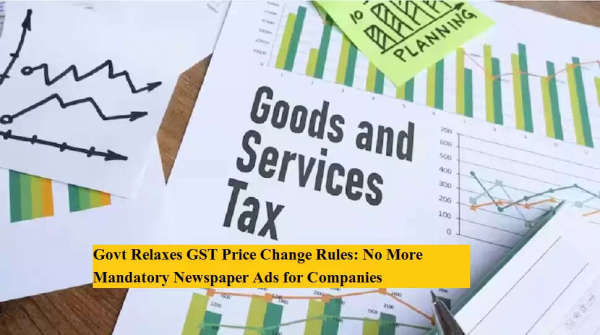
The central government has eased a major compliance burden for manufacturers and importers of pre-packaged goods. Until now, companies were required to publish advertisements in two newspapers whenever there was a change in Maximum Retail Price (MRP) due to tax revisions. This was mandated under Rule 18(3) of the Legal Metrology Rules. However, a new notification issued by the Ministry of Consumer Affairs on September 18, 2025, has removed this requirement, offering significant relief to businesses.
The revised rules come at a time when new Goods and Services Tax (GST) rates are set to take effect from September 22, 2025. These changes are part of a larger GST reform aimed at simplifying the tax structure and reducing the number of tax slabs.
Previously, any revision in GST rates meant manufacturers and importers had to inform consumers about the revised MRP through advertisements in at least two newspapers. This process was not only time-consuming but also added extra financial pressure on businesses.
Now, companies have been exempted from this rule. Instead of publishing ads, they are only required to issue circulars to wholesalers and retailers. A copy of this circular must also be submitted to the Director of Legal Metrology (Centre) and the Controllers of Legal Metrology in all states and union territories.
This shift ensures that key stakeholders in the supply chain are updated while reducing unnecessary costs for businesses.
The notification further clarifies that products manufactured before September 22, 2025, can be sold with or without a sticker mentioning the revised MRP. Applying a new sticker is optional, not compulsory. However, companies must ensure that the originally printed MRP on the packaging remains clearly visible.
To minimize waste, the government has also allowed businesses to continue using old packaging materials until March 31, 2026, or until the existing stock is exhausted—whichever comes earlier.
The decision coincides with a landmark reform in India’s GST framework. Earlier, the tax system had four slabs—5%, 12%, 18%, and 28%. The GST Council has now streamlined it to just two main slabs: 5% and 18%.
Additionally, items such as tobacco, cigarettes, and luxury products will fall under a special 40% slab. This simplification is expected to improve compliance, reduce confusion, and make the system more consumer-friendly.
With the elimination of the 12% and 28% slabs, many goods have been reassigned to either the 5% or 18% categories. As a result, several products will witness a shift in pricing from September 22 onwards.
The government has directed companies to ensure that these revised rates are communicated to their dealers and retailers before the new rates take effect. The objective is to make sure that the benefits of reduced GST are fully passed on to consumers, rather than being absorbed at the manufacturer or retailer level.
For companies, this change is a welcome move. By removing the burden of mandatory newspaper advertisements, businesses can cut down on compliance costs and focus more on operational efficiency. The option to use old packaging until March 2026 also prevents unnecessary financial loss and wastage of material.
For consumers, this reform promises more transparency and fairer prices in the market. As GST rates are rationalized and simplified, the government aims to ensure a smoother transition and better enforcement.
New GST rates will be implemented from September 22, 2025.
Companies no longer need to publish MRP changes in newspapers after tax revisions.
Businesses must issue circulars to wholesalers and retailers, and notify Legal Metrology authorities.
Applying new MRP stickers is optional, provided the original printed price remains visible.
Old packaging material can be used until March 31, 2026.
GST slabs have been reduced from four to two (5% and 18%), with a separate 40% slab for tobacco and luxury items.
This step is being hailed as a business-friendly reform that reduces red tape while ensuring consumer interests remain protected. As the new GST framework rolls out, both industries and buyers are set to experience a more streamlined system that balances efficiency with fairness.